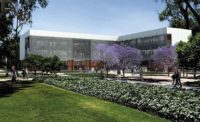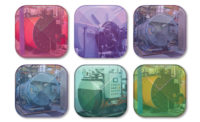As an engineer there are two choices — improve the “norm” or forge ahead with something new or borrowed from previous generations. Prior to Willis Carrier providing the first air conditioned building in 1904, building cooling relied on the environment, natural convection, and building mass to keep the occupants as comfortable as possible. What would happen if we push that old world envelope design tighter to make it more comfortable and consistent throughout the year by adding refrigerated cooling, heating, and diversity of the system by using a central cooling system?
Diversity is achieved by centralizing compressor cooling to allow for more turndown and thermal flywheel than individual systems serving individual rooms.
Larger systems also tend to be more efficient for less cost per unit of the capacity served. Schools with loads 150 tons and less should be served with a heat recovery chiller.
Loads larger than 150 tons should be cooled by highly efficient part load variable speed chiller or multi stage heat recovery chiller.
For the K-12 environment, the systems need to be simple and low maintenance. At the same time, the system should be long-lasting and energy-efficient in order to save local businesses and residents, who pay taxes for school improvements, from the prospect of increased taxes.
With these factors in mind, we will push the envelope of the concept of a “typical school.”
Two Paths
Like most designed systems, there is no one-system-fits-all. In a K-12 setting, two systems to be considered are: DOAS for the ventilation load for systems and radiant floor heating and cooling (new school projects); and for the second system, recirculating fan coil/air handler (existing schools).
The first system, when applied with a well-designed envelope, has the potential to be very energy-efficient, comfortable, and comparably priced to a conventional system. Noise with radiant systems will be non-existent, providing the best learning environment for the students. Radiant floor systems with DOAS tend to be priced similar to a VAV system and are potentially 10-15% less expensive. The benefits of a radiant cooling and heating floor system and DOAS are:
- Low overhead space requirements
- Uniform temperatures
- Low energy use index
- Quiet
- Reduces distribution of allergens
The disadvantages of radiant floor are:
- Expensive to install in existing buildings.
- Adding floor covering such as carpet or linoleum will reduce the efficiency of the floor.
- Economizer is more challenging to implement into a radiant system.
The second system is a DOAS system with recirculating air handlers or fan coils, with economizer for each of the spaces.
This system will not have the space benefits compared to radiant flooring, but it will benefit from heat recovery when feasible, lower cost for higher efficiency, and longer life compared to standard 15-year service systems. These systems should be considered when the buildings are existing.
Maintenance
When evaluating maintenance and service of the two systems, consider the following.
Radiant with DOAS
- Less filter changes.
- More central equipment maintenance other than floor circulators.
- For the smaller system with heat recovery, a drycooler can be used, which only adds maintenance of closed loop chemical treatment and can be minimized with the use of plastic piping.
- Chilled water maintenance of closed-loop chemical treatment can be minimized with the use of plastic piping. Also, with chilled water the addition of a cooling tower would increase maintenance.
Energy
Energy use for a radiant chilled water and hot water floor system is greatly reduced compared to a VAV air system. The reason for this is that a radiant system does not utilize moving air, which is energy-intensive, but rather moves water though the slab, which is less energy-intensive. Also, the temperature used for heating and cooling the slab is closer to the controlled space temperature, i.e. 10˚F and less versus 20˚F or more without an energy penalty, which also helps the chilled water and hot water production efficiency.
It is not uncommon for a variable-speed chiller plant to operate in the 0.36 to 0.5 kW/ton range overall these days. In addition, since radiant slabs are large mass loads, the rate of change of the chiller plant tends to be slower, which helps with the efficiency and operation of the plant.
Because the heating fluid requirement of a radiant slab is typically less than 120º supply, it is very easy to operate a condensing boiler system at condensing temperatures, resulting in efficiency at least in the mid 90% range. This is typically harder to perform in an air-based heating system.
Energy Model
The building modeled consisted of 19,000 sq ft of classrooms; 2,900 sq ft of library space; 3,800 sq ft of office space; 2,600 sq ft of restrooms; and 700 sq ft of corridors/stairwells.
Internal loads in the space were taken from ASHRAE 90.1 for their respective space type classification. The envelope values were modeled to be the equal of the baseline system within their respective ASHARE Climate zone and lighting loads were assumed to be the same for the baseline system and the proposed system. Weather files were taken from Los Angeles, Houston, Detroit, and Miami to represent the local weather of Los Angeles, Houston, Detroit, and Miami, respectively. The objective of the modeling is to compare the energy savings between the author’s proposed system and ASHRAE baseline system while maintaining thermal comfort and indoor air quality.
Design Values and Coefficients
A combined-space heat exchange coefficient was used during modeling of the radiant floors. The floor combined heat exchange coefficients can be assumed to be 1.23 Btu/h-ft2-˚F and 1.94 Btu/h-ft2-˚F for cooling and heating, respectively.
Room conditions
Cooling set point temperature: 78˚F
Cooling slab surface temperature: 66˚F
Heating set point temperature: 70˚F
Heating slab surface temperature: 84˚F
The school schedule was set to 8:00 a.m. to 8:00 p.m., Monday through Friday.
100% Outside Air Handling Unit
The supplemental 100% outside air system was set to supply a constant supply air temperature of 65˚F during hours of operation at a constant speed.
Heat Recovery Chiller
The heat recovery chiller was set to provide a constant supply temperature of 55˚F from the evaporator side and a constant supply temperature of 130˚F from the condenser side, with a Coefficient of Performance value of 4.
Cooling Tower/Pumps
The heat recovery system was modeled with a dry cooler and was set to have 10˚F approach with supply temperature of 110˚F, and a 20˚F delta T.
The chiller system was modeled with a cooling tower, an 8˚F approach and a supply temperature of 73˚F, and a 10˚F delta T.
Costs
Radiant heating/cooling slabs with DOAS cost less (10%-15% less) than a VAV system airside system (ductwork, piping, and controls). A recent project in San Diego cost $398,000 for 35,000 sq ft and 20 zones. Or roughly, $20,000 a zone. While this may seem high for each zone, also realize this is actually closer to a 40-yr system. Obviously radiant systems are conducive to class rooms and open offices. Small single-zone rooms may be better served by a recirculating fan coil with DOAS from a cost-benefit basis or combining like zones and averaging thermostats. The cost for the zones at the 60-ton school would be around $320,000, and the 180-ton school would be around $960,000.
Cost for a 60-ton heat recovery chilled and hot water plant may cost in the neighborhood of $350,000. This will include the chiller, boiler, pumps, piping, domestic hot water heat exchanger, and controls.
Cost for a 200-ton chiller and hot water plant may cost in the neighborhood of $500,000. This will include the chiller, boiler, pumps, piping, domestic hot water heat exchanger, and controls.
Total cost for the 60-ton school mechanical system with radiant slab would be $670,000. Total cost for the 180-ton school mechanical system with radiant slab would be $1,460,000.
A comparable cost of a package heat pump unit serving each of the zones for the 60-ton school would be $350,000 for an ASHRAE 90.1 installation. The 180-ton school would result in $1,050,000 for an ASHRAE 90.1 installation.
Energy Savings and Simple Payback
Table 1 the results from a small 60-ton school located in Los Angeles.
Although the time to payback is long with a flat rate structure, if time of use (TOU) is used then payback may decrease. Also, if the project is going for LEED or NZE status, it may be worthwhile for smaller buildings to provide heat recovery. Another added benefit of a radiant slab and DOAS is the excellent learning environment that it can provide by not cycling temperature and humidity associated with most DX systems, and by avoiding the air noise with nearly all conventional HVAC units.
Table 2 lists the results from a larger 180-ton school located in Los Angeles.
Because a variable-speed chiller plant is ultimately more energy-efficient than most DX systems or heat recovery, payback is a more favorable alternative than a heat recovery chiller plant option for a school. The only setback is that variable-speed chiller plants make sense for 150 tons and greater when high-performance part-load chillers can be used. All the benefits that apply for small school radiant slab apply for the larger variable-speed chiller plant.
Conclusion
There is no one size fits all approach to HVAC, and every approach has to be analyzed for the owner, budget, maintenance staff, and the requirements of the occupant. This article suggests looking at things differently than the norm and suggests maybe heat recovery and radiant slab with DOAS for smaller schools — or a highly efficient boiler plant and chiller plant with radiant slab and DOAS for larger schools — may be the answer for your next K-12 project. ES













